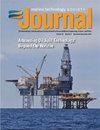Recent Development and Field Test of CO-OPS' Real-Time, Shallow Water CURrents BuoY (CURBY)
IF 0.7
4区 工程技术
Q4 ENGINEERING, OCEAN
引用次数: 0
Abstract
Abstract The National Oceanic and Atmospheric Administration (NOAA) National Ocean Service Center for Operational Oceanographic Products and Services (CO-OPS) manages the National Current Observation Program (NCOP) and Physical Oceanographic Real-Time Systems (PORTS®). These programs provide tide and current predictions, as well as real-time current and meteorological information. Outdated current predictions, navigational support requirements, and incident response scenarios (e.g., oil spills, vessel accidents) have highlighted CO-OPS' need for a rapidly deployable system that provides near-surface current and meteorological observations. To address this, CO-OPS designed, developed, and tested a real-time system based on a surface buoy platform, hereinafter referred as CURrents BuoY (CURBY). This paper provides an overview of the system design, field test results, operational applications, and future plans.In 2018, CO-OPS completed the build, integration, and testing of the first prototype CURBY. A successful field test was completed during 2018 in the Chesapeake Bay, and the first operational deployment followed shortly on the Delaware River in 2019. Resulting measurements were used to improve tidal current predictions and to plan for a 2021 regional survey. Initial success with tidal current survey operations led to design enhancement and wider use. During 2020‐2021, CO-OPS partnered with the NOAA Office of Response and Restoration to build two new CURBYs to support emergency response applications in the Gulf of Mexico region. During 2022, two CURBY systems were deployed in the Columbia River, Oregon, to support additional NCOP operations. Future plans include establishing a long-term CURBY system for Kings Bay, Georgia, PORTS®.CO-OPS实时浅水潮流浮标(CURBY)的最新研制与现场试验
摘要美国国家海洋和大气管理局(NOAA)国家海洋服务中心运营海洋学产品和服务(CO-OPS)管理着国家海流观测计划(NCOP)和物理海洋学实时系统(PORTS®)。这些程序提供潮汐和海流预测,以及实时海流和气象信息。过时的当前预测、导航支持要求和事件响应场景(例如,石油泄漏、船舶事故)突出了CO-OPS对提供近地表海流和气象观测的快速部署系统的需求。为了解决这一问题,CO-OPS设计、开发并测试了一个基于水面浮标平台的实时系统,以下简称CURrents buoy(CURBY)。本文概述了系统设计、现场测试结果、操作应用和未来计划。2018年,CO-OPS完成了第一个原型CURBY的构建、集成和测试。2018年在切萨皮克湾完成了一次成功的现场测试,2019年在特拉华河进行了第一次作战部署。所得测量结果用于改进潮流预测,并为2021年的区域调查做计划。潮流测量操作的初步成功导致了设计的改进和更广泛的使用。2020-2021年期间,CO-OPS与NOAA响应和恢复办公室合作,建立了两个新的CURBYs,以支持墨西哥湾地区的应急响应应用。2022年,在俄勒冈州哥伦比亚河部署了两个CURBY系统,以支持额外的NCOP行动。未来的计划包括为佐治亚州国王湾的PORTS®建立一个长期的CURBY系统。
本文章由计算机程序翻译,如有差异,请以英文原文为准。
求助全文
约1分钟内获得全文
求助全文
来源期刊

Marine Technology Society Journal
工程技术-工程:大洋
CiteScore
1.70
自引率
0.00%
发文量
83
审稿时长
3 months
期刊介绍:
The Marine Technology Society Journal is the flagship publication of the Marine Technology Society. It publishes the highest caliber, peer-reviewed papers, six times a year, on subjects of interest to the society: marine technology, ocean science, marine policy, and education.
 求助内容:
求助内容: 应助结果提醒方式:
应助结果提醒方式:


